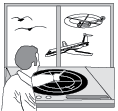
Judges compare two radar screens that track a seagull and a putative flying machine respectively. A machine passes if the judges can't distinguish it from the seagull on the radar screens. Failing the seagull test tells us nothing about flying in general, because only seagulls (or machines behaving exactly like them) could pass it. Non-seagull flyers (such as airplanes, helicopters, bats, etc) could never pass the test, because they would produce a distinctive radar signature.
Robert French, 1990.